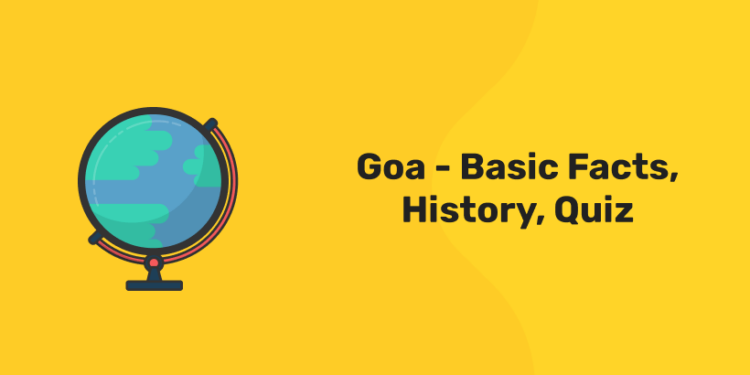Table of Contents
Goa is an Indian state that consists of a mainland district and an outlying island on the country’s southwest coast. It’s around 250 miles south of Mumbai (400 kilometres) (Bombay). It is bordered on the north by Maharashtra and Karnataka, on the east and south by the Arabian Sea, and on the west by the states of Maharashtra and Karnataka. On the north-central coast of the mainland district, Panaji (Panjim) serves as the capital. It was a Portuguese territory until 1962, when it was annexed by India and granted statehood in 1987.The 65-mile (105-km) coastline of mainland Goa is characterised by sandy beaches, estuaries, and promontories.
Goa’s diverse local population and Portuguese colonial legacy have created a unique cultural landscape. Christians and Hindus make up the majority of the population.
History of Goa
Goa’s history is rich, and its multi-cultural aesthetics are a reflection of that. It has seen constant changes that have left an indelible mark on its socioeconomic development. Let’s figure out why Goa is such a melting pot of cultures, faiths, beliefs, and customs!
Between 1700 and 1400 BC, the Harappan dynasty conquered Goa. They brought Southern culture and ideals with them, which may still be seen in the state today. The state offers a wide range of delectable South Indian delicacies. Also, the Harappans relied on maritime trade to thrive, and their transfer to Lothal allowed them to leave Goa.
Goa played an important role in the Western Mauryan Empire. For nearly four centuries, the scions of imperial Mauryas controlled Goa. The Chandragupt Maurya had conquered India’s western shore and given them the moniker Konkan Maurayas. The impact of the Mauryas’ official language on local dialects led in the development of Goa’s traditional Konkani language. Furthermore, around the 3rd century BC, Ashoka, the famous Buddhist Mauryan Emperor and grandson of Chandragupta Maurya, controlled the lotus-eating island. Buddhism arrived in Goa during the reign of Ashoka, when Buddhist monks formed the roots of the former faith.
The history of Goa reveals that the state has undergone significant modifications as a result of the region’s several rulers. From the 1st century BC to 1500 AD, Goa was ruled by Indo-Parthians, Bhojas, Chalukyas, Kadambas, Yadavas, and Bahamanis. The arrival of the Vijayanagar Empire in the 14th and 15th centuries A.D. put an end to their rule.
The defeat of the governing Sultan in 1510, as well as the return of Albuquerque, signalled the beginning of Portuguese control in Goa. They arrived in large fleets and established a permanent settlement at Velha. After that, the capital was moved to Panaji. For four centuries, the Portuguese had ruled over Goa.Vasco De Gama and other Portuguese explorers explored the maritime ways to Goa, leaving an indelible mark on the state’s history, as seen by the numerous attractions that still remain today. The Portuguese made Goa their centre in order to maintain lucrative control over the spice trade. It was discovered that the state was suitable for seafaring. Spices, corals, pearls, and silk, for example, were sold on separate streets. The Printing Press was established at Saint Paul’s College in Goa in 1556 as a result of Portuguese domination. The first printing press on the Asian continent was created here.
Goa entered its Golden Age thanks to the income from the spice trade. The Cathedral was built in the sixteenth century. It was not only the largest of all Asian churches, but it was also larger than those constructed in Portugal. It was the vice imperial capital for the Portuguese kings, with 300 churches and a population of 40,000 people.In 1961, it became an independent state of India, breaking free from the shackles of Portuguese rule. The history of Goa is a study of the different kingdoms and dynasties that controlled the state until it was eventually absorbed into India. This is why Goa has such a distinct culture and is marked by its distinctive customs.
Culture of Goa
1: Who was the first woman President of India?
Goan culture is a combination of both Eastern and Western elements, with the latter playing a more dominating role. It has been a Portuguese territory for nearly 450 years. The Deepastambha, the Cross, and the Ghode Modni are featured in the Goa tableau, which is followed by a chariot. King’s Western regalia, as well as regional dances showcasing Goa’s unique blend of religions and civilizations, are both part of the state’s cultural history. Christmas, Easter, Carnival, Diwali, Shigmo, Chavoth, Samvatsar Padvo, Dasara, and other major local festivities include: Many people go to Goa for the Carnival and the Christmas-New Year celebrations.
Free UPSKILLING Courses!
Take your first step toward mastering in-demand skills, acing interviews, and securing top-tier jobs with Entri's free upskilling courses.
Start Learning!Tourism in Goa
The tourist industry in Goa is primarily focused on the coastal areas, with less activity inland. In 2010, more than 2 million visitors were reported to have visited Goa, with over 1.2 million of them coming from outside the country.As of 2013, Goa was a popular party destination for Indian and foreign travelers with minimal funds, particularly Britons and Russians. The state hoped that by making modifications, it would be able to attract a more affluent populace is ranked 6th in National Geographic Travel’s Top 10 Nightlife Cities in the World.
Water sports are one of Goa’s most popular tourist attractions. Jet skiing, parasailing, banana boat rides, water scooter rides, and other activities are available at beaches such as Baga and Calangute. In CNN Travel’s Top 20 Beaches in Asia, Palolem’s Patnem beach came in third.
Visitors to Goa will find a cultural setting unlike any other in India, thanks to 450 years of Portuguese rule and the influence of Portuguese culture. Goa is frequently described as a blend of Eastern and Western culture, with Portuguese culture dominating the state’s architectural, cultural, and social contexts. Goa is well-known for its beautiful beaches, churches, and temples.
Interesting Facts about Goa
- Goa is a state on India’s southwest coast that is part of the Konkan area, which is separated from the Deccan highlands by the Western Ghats.
- North and South Goa are the two districts that make up the state. The Indian government appoints a district collector to oversee each district.
- Goa is India’s smallest state in terms of size and population.
- After Orissa, Goa is the second state in India where the world-famous olive ridley turtles come to lay their eggs in the Morjim.
- Among all Indian states, Goa has the highest GDP per capita.
- In 1842, the first medical school in India was founded in Panaji, Goa. In 2004, it was demolished.
- The politics of Goa are a result of the region’s distinctiveness as a result of 450 years of Portuguese control, as opposed to the rest of India’s three centuries of British colonialism.
- Goa boasts approximately 7,000 bars due to the large number of tourists.
- According to the Köppen climate classification, Goa has a tropical monsoon climate.
- Gomanchala, Gopakapattana, Gopakapattam, Gopakapuri, Govapuri, Govem, and Gomantak were some of the names given to Goa.
- Rock art engravings found in Goa exhibit the earliest traces of human life in India.
- Forests cover one-third of Goa’s area.
- The 310-meter-high Dudhsagar Falls is one of India’s tallest waterfalls.
- The Portuguese ruler officially surrendered on December 18th, and Goa became a part of India the next day. Goa commemorates this second independence day every year on December 19th.
- Goa was a part of the Maurya Empire in the third century BC, controlled by the Buddhist emperor Ashoka of Magadha.
Goa General Knowledge quiz
Q.1. The Portuguese shifted the capital from Old Goa to Panjim in this year.
A. 1834
B. 1840
C. 1843
D. 1856
Answer: C. 1843
Q.2. In the year 2000, who succeeded Francisco Sardinha as Goa’s chief minister?
A. Churchill Alemao
B. Wilfred De Souza
C. Luizino Faleiro
D. Manohar Parrikar
Answer: D. Manohar Parrikar
Q.3. Which of Goa’s cities is the largest in terms of area?
A. Vasco da Gama
B. Panaji
C. Margao
D. Ponda
Answer: A. Vasco da Gama
Q 4. Which state borders Goa to the north?
A. Kerala
B. Tamil Nadu
C. Maharashtra
D. Andhra Pradesh
Answer: C. Maharashtra
Q.5. Before Goa became a part of India, who was the ruler?
A. British
B. Dutch
C. Portuguese
D. French
Answer: C. Portuguese
Q.6. Which of Goa’s peaks is the highest?
A. Sonsogor
B. Vagheri Peak
C. Braganza Ghats
D. None of the above
Answer: A. Sonsogor
Q.7. Which language is Goa’s official language?
A. English
B. Hindi
C. Konkani
D. Marathi
Answer: C. Konkani
Q.8. What is Goa’s most popular sport?
A. field hockey
B. golf
C. cricket
D. football
Answer: D. football
Q.9. How many Rajya Sabha seats are there in Goa?
A. 1
B. 4
C. 7
D. 2
Answer: A. 1
Q.10. Which Goa chief minister eventually became the Legislative Assembly’s speaker?
A. Bandodkar
B. Pratapsinh Rane
C. Shashikala Kakodkar
D. Ravi Naik
Answer: B. Pratapsinh Rane













